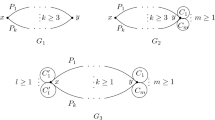Abstract
In this paper, we study Roman {k}-dominating functions on a graph G with vertex set V for a positive integer k: a variant of {k}-dominating functions, generations of Roman \(\{2\}\)-dominating functions and the characteristic functions of dominating sets, respectively, which unify classic domination parameters with certain Roman domination parameters on G. Let \(k\ge 1\) be an integer, and a function \(f:V \rightarrow \{0,1,\dots ,k\}\) defined on V called a Roman \(\{k\}\)-dominating function if for every vertex \(v\in V\) with \(f(v)=0\), \(\sum _{u\in N(v)}f(u)\ge k\), where N(v) is the open neighborhood of v in G. The minimum value \(\sum _{u\in V}f(u)\) for a Roman \(\{k\}\)-dominating function f on G is called the Roman \(\{k\}\)-domination number of G, denoted by \(\gamma _{\{Rk\}}(G)\). We first present bounds on \(\gamma _{\{Rk\}}(G)\) in terms of other domination parameters, including \(\gamma _{\{Rk\}}(G)\le k\gamma (G)\). Secondly, we show one of our main results: characterizing the trees achieving equality in the bound mentioned above, which generalizes M.A. Henning and W.F. klostermeyer’s results on the Roman {2}-domination number (Henning and Klostermeyer in Discrete Appl Math 217:557–564, 2017). Finally, we show that for every fixed \(k\in \mathbb {Z_{+}}\), associated decision problem for the Roman \(\{k\}\)-domination is NP-complete, even for bipartite planar graphs, chordal bipartite graphs and undirected path graphs.

Similar content being viewed by others
References
Booth KS, Johnson JH (1982) Dominating sets in chrodal graphs. SIAM J Comput 11(1):191–199
Brešar B, Henning MA, Rall DF (2008) Rainbow domination in graphs. Taiwan J Math 12:213–225
Chang GJ, Li B-J, Wu J (2013) Rainbow domination and related problems on strongly chordal graphs. Discrete Appl Math 161:1395–1401
Chellali M, Haynes TW, Hedetniemi ST, McRae AA (2016) Roman 2-domination. Discrete Appl Math 204:22–28
Clark BN, Colbourn CJ, Johnson DS (1990) Unit disk graphs. Discrete Math 86(1–3):165–177
Cockayne EJ, Dreyer PA Jr, Hedetniemi SM, Hedetniemi ST (2004) Roman domination in graphs. Discrete Math 278:11–22
Domke GS, Hedetniemi ST, Laskar RC, Fricke G (1991) Relationships between integer and fractional parameters of graphs. In: Alavi Y, Chartrand G, Oellermann O, Schwenk A (eds) Proceedings of the sixth quadrennial conference on the theory and applications of graphs, Western Michigan University. Graph theory, combinatorics and applications, vol 1. Wiley, New York, pp 371–387
Fink JF, Jacobson MS (1985) \(n\)-domination in graphs. In: Graph theory with applications to algorithms and computer science (Kalamazoo, Michigan, 1984). Wiley, New York, pp 283–300
Haynes TW, Hedetniemi ST, Slater PJ (1998) Fundamentals of domination in graphs. Marcel Dekker Inc, New York
Henning MA (2002) A charaterization of Roman trees. Discuss Math Graph Theory 22:325–334
Henning MA, Klostermeyer WF (2017) Italian domination in trees. Discrete Appl Math 217:557–564
Hon W-K, Kloks T, Liu H-H, Wang H-L (2016) Rainbow domination and related problems on some classes of perfect graphs. In: Hajiaghayi M, Mousavi M (eds) Topics in theoretical computer science-TTCS 2015. Lecture notes in computer science, vol 9541. Springer, Cham, pp 121–134
Klostermeyer WF, MacGillivray G (2019) Roman, Italian, and 2-domination. J Combin Math Combin Comput 108:125–146
Liu C-H, Chang GJ (2013) Roman domination on strongly chordal graphs. J Comb Optim 26:608–619
Müller H, Brandstädt A (1987) The NP-completeness of Steiner tree and dominating set for chordal bipartite graphs. Theor Comput Sci 53:257–265
Schnupp M (2006) Broadcast domination with flexible powers. Diplomarbeit, University of Jena, Germany
Acknowledgements
The authors would like to thank anonymous reviewers for their helpful comments and suggestions which lead to a considerably improved presentation. This work was funded in part by National Natural Science Foundation of China (Grants Nos. 11201205, 11571155).
Author information
Authors and Affiliations
Corresponding author
Additional information
Publisher's Note
Springer Nature remains neutral with regard to jurisdictional claims in published maps and institutional affiliations.
Rights and permissions
About this article
Cite this article
Wang, CX., Yang, Y., Wang, HJ. et al. Roman {k}-domination in trees and complexity results for some classes of graphs. J Comb Optim 42, 174–186 (2021). https://doi.org/10.1007/s10878-021-00735-z
Accepted:
Published:
Issue Date:
DOI: https://doi.org/10.1007/s10878-021-00735-z



